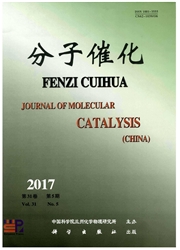

 中文摘要:
中文摘要:
为了调控含腈基功能烯烃的催化氢甲酰化反应,设计合成了不同表面酸性的钛氧纳米管和Zr-掺杂钛氧纳米管负载Rh催化剂(Rh/TNTs,Rh/Zr-TNTs).随Zr掺杂量的增加,Zr-掺杂钛氧纳米管的表面酸性提高.用XRD、XPS、FT-IR、TEM和低温N2吸脱附等对所合成的催化剂进行了结构及组成表征.催化剂没有显现出与Rh和Zr相关的XRD衍射峰,Rh在纳米管中高度分散; Zr-掺杂钛氧纳米管的比表面积比纯钛氧纳米管的要高,催化剂的比表面积随着载Rh量的增加而减小,其中Rh0百分率也会降低; FT-IR测试结果表明,催化剂中Rh能对CO进行端基羰基式化学吸附.以2-甲基-3-丁烯腈为底物,评价所合成的催化剂对含腈基功能烯的氢甲酰化的催化性能,催化活性随载Rh量而变化,最佳值为0.13 w; 提高催化反应温度虽能增加2-甲基-3-丁烯腈的转化率,但也有利于它的异构化; 和Rh/TNTs相比,Rh/Zr-TNTs要求的催化温度稍高,Rh/Zr-TNTs表面更强的B酸性有利于催化反应生成直链产物醛.催化剂Rh/Zr-TNTs中的L酸催化活性中心和表面的B酸协同效应是催化2-甲基-3-丁烯腈生成直链醛的主要因素.
 英文摘要:
英文摘要:
To develop an efficient catalyst system for hydroformylation of functionalized olefin containing -CN func- tional group, titania and Zr-doped titania nanotubes supported Rh-catalysts were synthesized. The catalysts were characterized with XRD, XPS, FT-IR, TEM and N2 adsorption-desorption. The surface acidity of catalysts in- creased with the increase of Zr-content in the catalysts. XRD patterns for catalysts did not show the diffraction peak related to Rh, which should be ascribed to that Rh was highly dispersed on the outer and inner surface of nano- tubes. The SSA of Zr-doped titania nanotubes was higher than that of primary one, and with the increase of Rh- loading amount the SSA of catalysts decreased, but the percentage of Rh0 state in the catalysts dropped slightly. The chemisorption of CO on Rh0 showed a clear FT-IR peak at 1 802.65 cm-l. 2-methyl-3-butenenitrile (2M3BN) was used as a substrate to evaluate the catalytic activity of catalysts for hydroformylation. The catalysts all displayed catalytic activity for the hydroformylation reaction of olefin containing -CN functional group and the activity varied with the Rh-loading amount, the optimal Rh-loading amount was about 0.13%. Raising reaction temperature was favorable for the conversion of 2M3BN, but high temperature would lead to higher isomerization yield of 2M3BN. The B-acid on Rh/Zr-TNTs was favorable for the formation of linear aldehyde. The ratio of linear to branched aldehyde increased with the raising of B-acidity on catalysts.
 同期刊论文项目
同期刊论文项目
 同项目期刊论文
同项目期刊论文
 THE INFLUENCE OF PLATINUM ON THE STRUCTURE AND PHOTOCATALYTIC PERFORMANCE OF HYDROGEN TITANATE NANOT
THE INFLUENCE OF PLATINUM ON THE STRUCTURE AND PHOTOCATALYTIC PERFORMANCE OF HYDROGEN TITANATE NANOT Synthesis, Structure, and Spectral and Magnetic Properties of a Three-dimensional Cobalt(II)-Neodymi
Synthesis, Structure, and Spectral and Magnetic Properties of a Three-dimensional Cobalt(II)-Neodymi Monometallic nickel and bimetallic nickel-europium complexes based on oxydiacetic acid and N-heteroc
Monometallic nickel and bimetallic nickel-europium complexes based on oxydiacetic acid and N-heteroc Cobalt and cadmium complexes with N-heterocyclic dicarboxylic acid ligands: Syntheses, structures, m
Cobalt and cadmium complexes with N-heterocyclic dicarboxylic acid ligands: Syntheses, structures, m Characterization of Pt catalysts supported by three forms of TiO2 and their catalytic activities for
Characterization of Pt catalysts supported by three forms of TiO2 and their catalytic activities for 期刊信息
期刊信息
